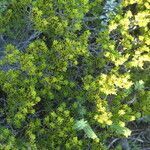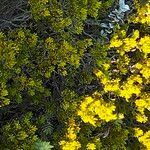Erect shrubs up to about 30 cm (1 ft). Branches many, slender, puberulous or glabrous, heaves 3-nate, more rarely 4-nate, 5-8 mm long, linear-trigonous, obtuse, faintly sulcate, spreading or incurved, imbricate, glabrous. Flowers mostly in pairs in the leaf axils forming a narrow, sometimes dense pseudo-spike; peduncles 1-3 mm long, puberulous; bracts minute, remote, ciliate. Sepals 1 mm long, or about equal to the corolla-tube, ovate or lanceolate, acute, keeled, glabrous, greenish. Corolla 1.5 mm long or less, widely campanulate or cyathiform, glabrous, dry, rosy or sordid yellow; lobes upright to spreading about equal to the tube, obtuse. Anthers included to manifest, 0.8 mm long, subovate, muticous; pore about 1/2 the length of the cell or less. Ovary ovoid, glabrous; style exserted; stigma cyathiform.
Erect to sprawling, multistemmed, resprouting shrublet to 30(-90) cm. Flowers tiny, reddish.


